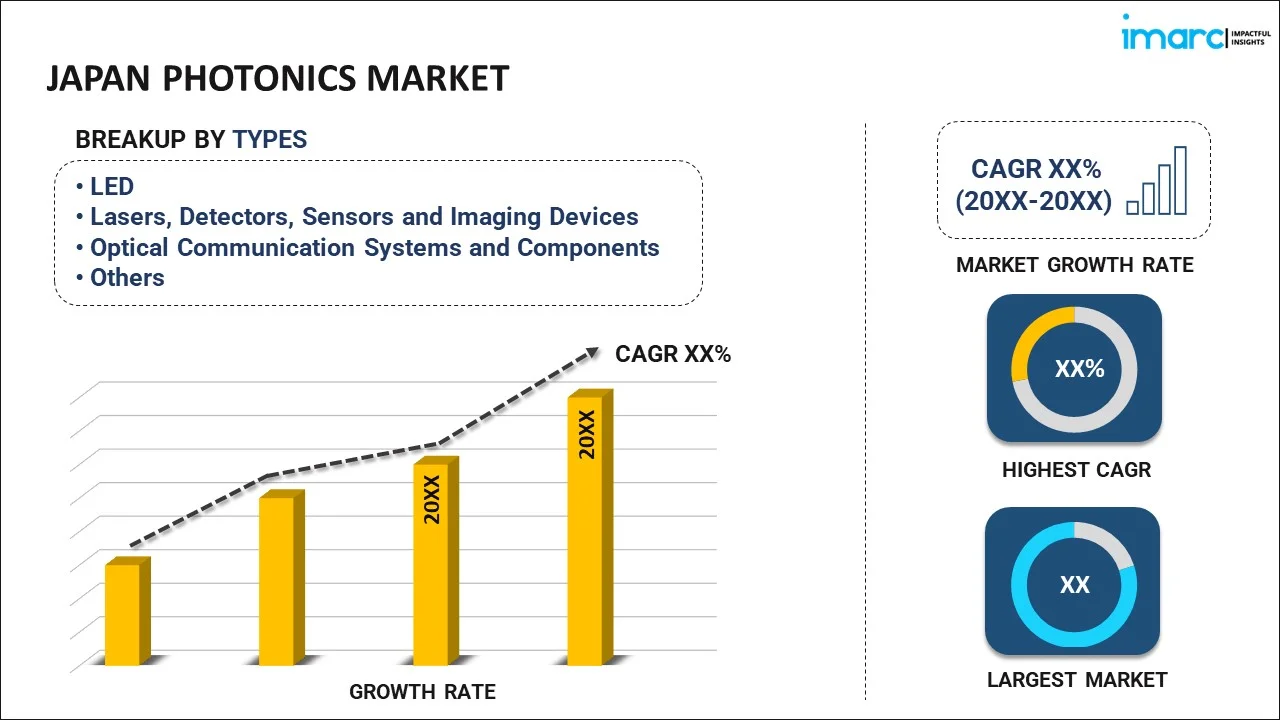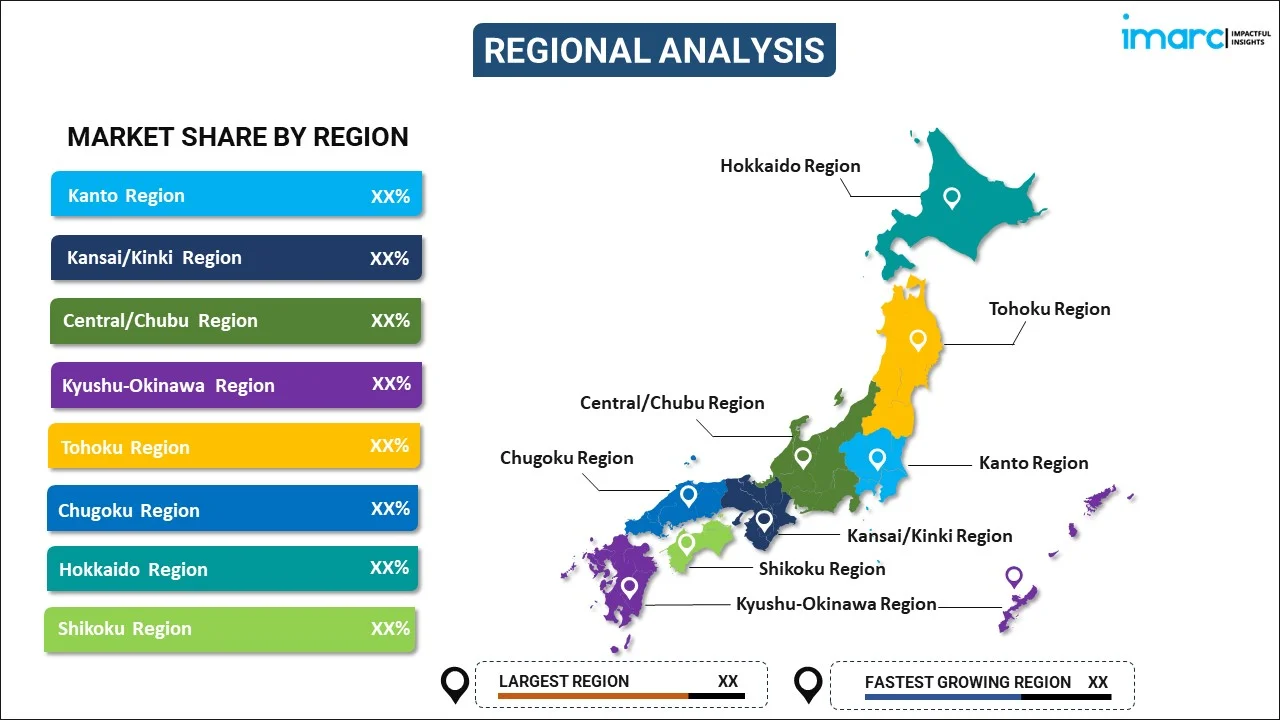
Japan Photonics Market Report by Type (LED, Lasers, Detectors, Sensors and Imaging Devices, Optical Communication Systems and Components, and Others), Application (Surveying and Detection, Production Technology, Data Communication, Image Capture and Display, Medical Technology, Lighting, and Others), End User (Building Construction, Media, Broadcasting and Telecommunication, Consumer Electronics, Medical, Safety and Defense, Industrial), and Region 2025-2033
Market Overview:
Japan photonics market size is projected to exhibit a growth rate (CAGR) of 7.8% during 2025-2033. The increasing demand for photonics technologies like lasers and optical sensors, which are used in precision manufacturing processes, such as cutting, welding, and quality control, is driving the market.
|
Report Attribute
|
Key Statistics
|
|---|---|
|
Base Year
|
2024 |
|
Forecast Years
|
2025-2033
|
|
Historical Years
|
2019-2024
|
| Market Growth Rate (2025-2033) | 7.8% |
Photonics is a branch of science and technology that deals with the generation, manipulation, and detection of light, particularly in its fundamental particle form, the photon. It encompasses a wide range of applications and devices that rely on the properties of photons to transmit and process information. Photonics has had a profound impact on various fields, including telecommunications, where optical fibers enable high-speed data transmission. It also plays a crucial role in lasers, which find applications in surgery, manufacturing, and research. Photonics is vital in sensing and imaging technologies, such as cameras and medical imaging devices like MRI and CT scanners. Furthermore, it underpins emerging technologies like quantum computing and photovoltaics, contributing to more efficient solar energy conversion. In summary, photonics is the science and technology of harnessing light to revolutionize industries, communication, and understanding of the physical world, with implications for both current and future technological advancements.
Japan Photonics Market Trends:
The photonics market in Japan is a burgeoning industry, with several key drivers fueling its rapid growth. Firstly, the increasing demand for high-speed data transmission and communication systems is propelling the photonics market forward. As regional data traffic continues to surge, the need for faster and more efficient optical communication networks has become paramount. Additionally, the integration of photonics in various industries, such as healthcare and automotive, is another crucial factor driving market expansion. Photonics plays a pivotal role in medical diagnostics, laser surgeries, and autonomous vehicles, enhancing their capabilities and safety. Furthermore, the push for energy-efficient technologies is a significant driver. Photonics enables energy-efficient lighting solutions like LEDs, reducing energy consumption and environmental impact. Moreover, the development of photonics in sensors and imaging technologies is enhancing automation and robotics, impacting industries from manufacturing to agriculture. Additionally, numerous government initiatives and investments in R&D are fostering innovation and market growth. This collaboration between academia and industry, which is accelerating the development of cutting-edge photonics applications, is expected to drive the market in Japan during the forecast period.
Japan Photonics Market Segmentation:
IMARC Group provides an analysis of the key trends in each segment of the market, along with forecasts at the country level for 2025-2033. Our report has categorized the market based on type, application, and end user.
Type Insights:

- LED
- Lasers, Detectors, Sensors and Imaging Devices
- Optical Communication Systems and Components
- Others
The report has provided a detailed breakup and analysis of the market based on the type. This includes LED, lasers, detectors, sensors and imaging devices, optical communication systems and components, and others.
Application Insights:
- Surveying and Detection
- Production Technology
- Data Communication
- Image Capture and Display
- Medical Technology
- Lighting
- Others
A detailed breakup and analysis of the market based on the application have also been provided in the report. This includes surveying and detection, production technology, data communication, image capture and display, medical technology, lighting, and others.
End User Insights:
- Building Construction
- Media, Broadcasting and Telecommunication
- Consumer Electronics
- Medical
- Safety and Defense
- Industrial
The report has provided a detailed breakup and analysis of the market based on the end user. This includes building construction, media, broadcasting and telecommunication, consumer electronics, medical, safety and defense, and industrial.
Regional Insights:

- Kanto Region
- Kansai/Kinki Region
- Central/ Chubu Region
- Kyushu-Okinawa Region
- Tohoku Region
- Chugoku Region
- Hokkaido Region
- Shikoku Region
The report has also provided a comprehensive analysis of all the major regional markets, which include Kanto Region, Kansai/Kinki Region, Central/ Chubu Region, Kyushu-Okinawa Region, Tohoku Region, Chugoku Region, Hokkaido Region, and Shikoku Region.
Competitive Landscape:
The market research report has also provided a comprehensive analysis of the competitive landscape. Competitive analysis such as market structure, key player positioning, top winning strategies, competitive dashboard, and company evaluation quadrant has been covered in the report. Also, detailed profiles of all major companies have been provided.
Japan Photonics Market Report Coverage:
| Report Features | Details |
|---|---|
| Base Year of the Analysis | 2024 |
| Historical Period | 2019-2024 |
| Forecast Period | 2025-2033 |
| Units | Million USD |
| Scope of the Report | Exploration of Historical Trends and Market Outlook, Industry Catalysts and Challenges, Segment-Wise Historical and Future Market Assessment:
|
| Types Covered | LED, Lasers, Detectors, Sensors and Imaging Devices, Optical Communication Systems and Components, Others |
| Applications Covered | Surveying and Detection, Production Technology, Data Communication, Image Capture and Display, Medical Technology, Lighting, Others |
| End Users Covered | Building Construction, Media, Broadcasting and Telecommunication, Consumer Electronics, Medical, Safety and Defense, Industrial |
| Regions Covered | Kanto Region, Kansai/Kinki Region, Central/ Chubu Region, Kyushu-Okinawa Region, Tohoku Region, Chugoku Region, Hokkaido Region, Shikoku Region |
| Customization Scope | 10% Free Customization |
| Post-Sale Analyst Support | 10-12 Weeks |
| Delivery Format | PDF and Excel through Email (We can also provide the editable version of the report in PPT/Word format on special request) |
Key Questions Answered in This Report:
- How has the Japan photonics market performed so far and how will it perform in the coming years?
- What has been the impact of COVID-19 on the Japan photonics market?
- What is the breakup of the Japan photonics market on the basis of type?
- What is the breakup of the Japan photonics market on the basis of application?
- What is the breakup of the Japan photonics market on the basis of end user?
- What are the various stages in the value chain of the Japan photonics market?
- What are the key driving factors and challenges in the Japan photonics?
- What is the structure of the Japan photonics market and who are the key players?
- What is the degree of competition in the Japan photonics market?
Key Benefits for Stakeholders:
- IMARC’s industry report offers a comprehensive quantitative analysis of various market segments, historical and current market trends, market forecasts, and dynamics of the Japan photonics market from 2019-2033.
- The research report provides the latest information on the market drivers, challenges, and opportunities in the Japan photonics market.
- Porter's five forces analysis assist stakeholders in assessing the impact of new entrants, competitive rivalry, supplier power, buyer power, and the threat of substitution. It helps stakeholders to analyze the level of competition within the Japan photonics industry and its attractiveness.
- Competitive landscape allows stakeholders to understand their competitive environment and provides an insight into the current positions of key players in the market.
Need more help?
- Speak to our experienced analysts for insights on the current market scenarios.
- Include additional segments and countries to customize the report as per your requirement.
- Gain an unparalleled competitive advantage in your domain by understanding how to utilize the report and positively impacting your operations and revenue.
- For further assistance, please connect with our analysts.
 Inquire Before Buying
Inquire Before Buying
 Speak to an Analyst
Speak to an Analyst
 Request Brochure
Request Brochure
 Request Customization
Request Customization




.webp)




.webp)












